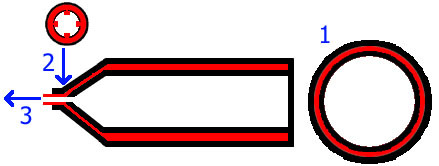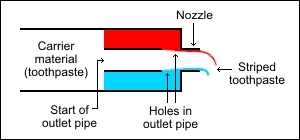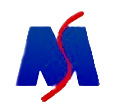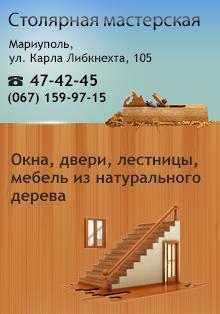На главную
- Мариуполь
- Украина
- Мариуполь
- Луганск
- Крым
- Херсон
- Одесса
- Николаев
- Запорожье
- Днепропетровск
- Харьков
- Сумы
- Чернигов
- Житомир
- Киев
- Луцк
- Львов
- Полтава
- Черкассы
- Кировоград
- Черновцы
- Тернополь
- Хмельницкий
- Винница
- Ужгород
- Ивано-франковск
- Ровно
- Севастополь
Как закачивается трехцветная паста в тюбик?
Главная -> Энциклопедия ->Как закачивается трехцветная паста в тюбик? И они не мешиваются
Ответ есть в Английской Википедии.Оттуда
Также вам будет интересно: Почему Англию называют Альбионом?И кто?
 |
Striped toothpaste
How stripes are produced in toothpaste
Striping of toothpaste is solely for the purpose of providing an alternative appearance; it provides no functional benefit to the consumer.Striped toothpaste can be produced by including two different colored toothpastes in an unusual type of packaging. The collapsible tube has two tanks, one filled with each color paste (see figure). Squeezing the tube pushes the two pastes out the opening. The tube nozzle layers the pastes to produce a striped pattern.To keep the cost of packaging to a minimum, it is now common for tubes to be filled with striped paste (e.g. Aquafresh). As the tube is squeezed, the stripes flow parallel to each other and do not mix. The patterned paste that gets dipensed is simply a narrower version of what is in the tube. Filling is done using a multi-nozzle filling head that dispenses a different colored stripe in each direction. To keep the stripes parallel to the axis of the tube, the head starts at the bottom and retracts as it fills, staying just above the level of the paste. Tubes with two compartments are generally reserved for toothpastes containing two formulas intended to react together and therefore kept isolated until dispensed (e.g. Colgate Simply White).
Перевожу смысл. Паста в тюбике расположена так, что каждый цвет находится в своем собственном тюбике (внутри основного) и разумеется не смешивается.
------------------------------Добавление
Из
Ever wondered how they get the stripes on the toothpaste? Some people even avoid buying those stripy toothpastes just so they don't have to even think about this.
But it's easier than it seems. And no, there are not two separate compartments (cf the drawing below). The tube is filled with the carrier material, the actual toothpaste, which is usually white, to a certain level. Above that level, the tube is filled with the 'stripe' stuff, which is usually red, blue or green. Both materials are viscous enough so that they don't mix. Now the trick is to let these two substances out separate ways but at the same time. The toothpaste nozzle is not just a hole at the top of the tube. Instead, it is a longish pipe that reaches down the tube just ending at the filling level of the carrier material. The pipe has small holes in it further up closer to the nozzle. Pressing the tube will cause the carrier material to enter the outlet pipe and press the stripe stuff. The stripe material will enter the outlet pipe through the small holes, which is where the stripes are generated.
 |
Переводится примерно так же, с поправкой на то что разного цвета паста отделена друг от друга неким гибким материалом с дырками около выхода пасты из тюбика.
Ну и конечно, как ни мни тюбик - полоски не смешаются.
Во!
Источник: http://otvet.mail.ru/question/7962478/
Loading...
Изучайте вместе с LifeCity:
Предприятия Мариуполя
-

Ледовый комплекс "Айсберг"
6 Августа 2009
-

Компания МедиаСвит
09 июня 2011
-

Кинотеатр Победа
14 апреля 2009
-

Столярка — столярные изделия в Мариуполе
10 Июля 2008
-

Пиявик
13 Апреля 2008
-

Liocom — компьютеры и комплектующие
27 Февраля 2009
Хотите быть в этом списке?
Пишите нам!

